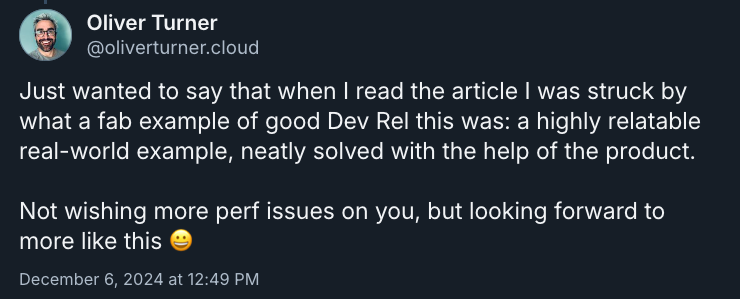Discover how to classify DevRel content to understand what works for your team. Learn about 4 content types, their goals, and leading themes.
In working toward a way to define attributable paths to real quantitative business value in Developer Relations (DevRel), which I discussed at the end of this previous article, I recently conducted a content classification exercise to understand the different types of DevRel output at Sentry (where I am currently am employed) and their underlying themes, using over 230 real content pieces. The exercise involved:
labelling each content piece with a “type” (Academic, Guide, Tutorial), and
identifying the “Leading Theme” of the piece (Product/SEO, Contrived Example, Real Experience).
Here’s a small snapshot of the data using some of my own content as examples:
| Title | URL | Type | Leading Theme |
|---|---|---|---|
| How to deal with API rate limits | https://blog.sentry.io/how-to-deal-with-api-rate-limits/ | Academic | Contrived Example |
| How I fixed my brutal TTFB | https://blog.sentry.io/how-i-fixed-my-brutal-ttfb/ | Guide | Real Experience |
| Sentry can’t fix React hydration errors, but it can really help you debug them | https://blog.sentry.io/sentry-cant-fix-react-hydration-errors-but-it-can-really-help-you-debug-them | Tutorial | Contrived Example |
| What is INP and why you should care | https://blog.sentry.io/what-is-inp/ | Academic | Product/SEO |
| How to make your web page faster before it even loads | https://blog.sentry.io/how-to-make-your-web-page-faster-before-it-even-loads/ | Guide | Contrived Example |
I discussed this data with Sarah Guthals, and compared it with her own independent analysis of the same content. We also collected some quantitative data on some of the highest and lowest performing content pieces based on “views” and “visits to the sign up form”. This led us to formally define four types of DevRel content, where each should communicate a particular Leading Theme as standard.
The 4 types of DevRel content
Whereas we initially defined three types of content and used these to categorise existing pieces, we agreed to expand the types to four, which were more representative of what we wanted to aim for: Academic, Guide, Dev Tips, and Tutorial. The Leading Themes are described as follows (in the context of DevRel at Sentry):
Product: How Sentry helps
Contrived Example: How Sentry can help in a particular (potentially abstract) challenge
Real Experience: How Sentry helped in a real product with real users
The table below aims to concisely communicate the preferred Leading Theme and Goal of each of the four types of DevRel content. Where I have used the word “TOOL”, this would usually be substituted for the name of the product or company you are writing/recording/speaking about or for (i.e. Sentry). I have included representative examples of my own content to practically demonstrate each type.
| Type | Leading Theme | Goal | Example | URL |
|---|---|---|---|---|
| Academic | Product | To demonstrate a concept that affects developers, using TOOL | What is INP and why you should care | https://blog.sentry.io/what-is-inp/ |
| Guide | Real Experience | To demonstrate how to solve a specific challenge using TOOL | How I reduced an API call from >5 seconds to under 100ms | https://blog.sentry.io/how-i-reduced-an-api-call-from-greater-than-5-seconds-to-under-100ms/ |
| Dev Tips | Contrived Example | To demonstrate how to accomplish a smaller task using TOOL | How to deal with API rate limits | https://blog.sentry.io/how-to-deal-with-api-rate-limits/ |
| Tutorial | Product | To demonstrate, step by step, how to go from nothing to a working example using TOOL | Using Hooks To Monitor & Error Track With Sentry | https://docs.directus.io/blog/hooks-monitoring-error-tracking-sentry.html |
Which type of content “converts” better (and therefore provides more business value)?
The type of content that performed best in our content database was Guides. Now, the content that we produce as DevRel, isn't necessarily aimed at converting readers to sign-ups as a standalone effort; each piece of content is part of a larger campaign to educate developers on topics, challenges, and solutions for which the TOOL is useful. So while our conversion rate from view > visit to the sign up page was around 3% for Guides, we leverage that as an early indicator of success, not as our singular success metric.
As a result of this, and given our discussions internally, a company with a TOOL like Sentry should focus larger chunks of DevRel time on Guides and Dev Tips. From experience, Guides and Dev Tips are:
less time-consuming to create, and
easier to centre on real examples and experience than Tutorials or Academic pieces.
In focussing your efforts on Guides and Dev Tips, you should end up being able to deliver more value (e.g. conversion however you define it) more efficiently, whilst at the same time providing developers with clear real-world examples of challenges and successes. For example, in response to my latest Guide How I reduced an API call from >5 seconds to under 100ms, Blueskyer Oliver Turner said “what a fab example of good Dev Rel this was: a highly relatable real-world example, neatly solved with the help of the product.”

Stop creating SEO-first content
Notice how SEO (Search Engine Optimisation) is not a leading theme in this framework, despite being used in the original classification exercise. In DevRel, we know content is often created because companies want to show up in search engines for certain keywords, but, interestingly (or perhaps, not-so-interestingly), SEO-first content tended to be the worst performing in terms of conversion from views > visits to a sign up form in our limited dataset, with the exception of a few timely pieces such as What is INP and why you should care. It could also be argued that, despite the main motivation for writing this piece being heavily weighted toward SEO, it ended up being a Guide anyway — which is the better approach.
As someone working in DevRel, you may receive requests related to using keywords so that a company can show up in search results (coincidentally my INP post was the top featured post on Google when INP was launched), but you will be doing your company a disservice by leading a piece of content with SEO. In DevRel, your job is to create something useful for developers, and depending on your usual audience, a Guide or a Dev Tip is probably preferable. In the INP post, I intentionally did not lead with SEO, but addressed a real topic facing developers today (INP), was aware of the company's desire to show up in search results for INP, and yet focused on providing actionable insights for developers.
There is a particular piece of content I wrote (not at Sentry) that haunts me because I wrote it entirely for SEO purposes on the suggestion of a colleague in marketing, and did so begrudgingly. It is probably the only piece I did not archive on my own domain. Let me know if you ever track it down and we can laugh/cry together.
Do this exercise for yourself
I would highly recommend doing the content classification exercise for content that your DevRel team has created to help you identify:
whether the right things for your team and company product are determining your Leading Themes,
whether your content pieces have clearly defined goals, and
whether you have any gaps in your content types.
To get you started, I’ve put together a template in Google Sheets, where you can list your content pieces and start categorising by type and Leading Theme. I’ve included the Product/SEO Leading Theme despite it not being the most desirable one in DevRel, given this is a useful insight into how content is often created. Open the DevRel Content Classification spreadsheet, make a copy, and give it a go. If you have data available relating to your success metrics, see if you can find any correlation between the different types of content approaches and success. I’d love to know what you discovered — let me know on Bluesky!
🦋 likes on Bluesky
Like this post on Bluesky to see your face on this page
Salma Alam-Naylor
I'm a live streamer, software engineer, and developer educator. I help developers build cool stuff with blog posts, videos, live coding and open source projects.


